Sarah Gerdes's Blog, page 8
July 13, 2019
A visit to Castle Soave in Verona’s wine country
After three days in Bellagio and Lake Como, we were ready to
head out of town. Because of the location we chose and the general road
challenges that exist on Bellagio (no cabs allowed, only car and driver,
walking or bike, and of course, parking limitations) we grew fatigued of trying
to avoid getting hit as we squished ourselves against the walls as cars zipped
by. And while I don’t mind a periodic good look at the rock wall now and then,
when I can make out individual strands of grass as Rog tries to avoid oncoming
traffic, it’s time to go.
The drive to Verona from Bellagio, Italy a straight and easy one, with the exception of several road construction projects that weren’t identified on either Google maps or our internal GPS system. It wasn’t a serious problem, but annoying when you lose ten minutes here and there.

In the San Briccio valley of Verona, heading up to our rented villa. This is a northwest facing view.
The heart of wine country
Located on the outskirts of Verona, both towns of San Briccio and Soave (pronounced So-ahh-veh), are both identified as Verona, and a suburb within. As such, the town is listed, and as a (VR) behind it. It would be like saying Russian Hill in San Francisco and the signs reading: Russian Hill (SF). The Italians make it easy so locals and foreigners alike understand where they are at all the time.
San Briccio is about fifteen minutes outside the center of Verona. The owners of the three-story villa we rented are both architects, and lived in this home as they raised their two children. When the kids became teens, the family moved into Verona proper, the “scenic” drive through the mountain roads too much, especially during high traffic times where the drive is more like forty.

The hilltop homes of San Briccio offer a 360 degree view of the valleys below–stretching northeast of Verona, pictured above.
Winding up from the valley through acres of non-stop wine fields, to the mountain top offering a panoramic, 360-degree view of the San Briccio valley below. We could see the neighboring town of Soave, and the fortress castle in the distance.


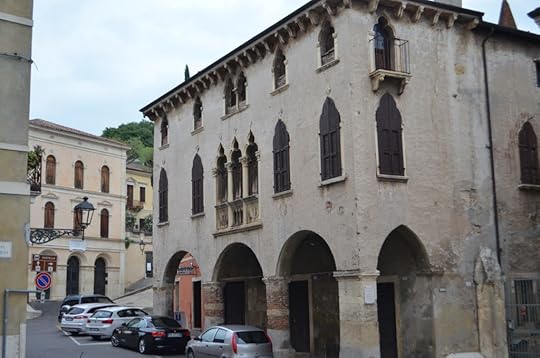
Free parking on the street (hurray), walking over a canal (upper left), the mainstreet at 4 p.m. in the Castle Soave township (upper right) and the walk to the end of the street. The building at the left is where you turn right, walk up a 1/16th of a mile and you are at the caretakers home.
On both sides of the hill are miles of wine fields, the area producing dozens of brands of vino. The surrounding hills have been cultivated in stair-stepped manner to provide the largest yield. We can appreciate the effort and beauty even if we don’t drink the stuff, but our wildest culinary dreams were met with the food, so don’t cry for me Argentina, we haven’t gone without.
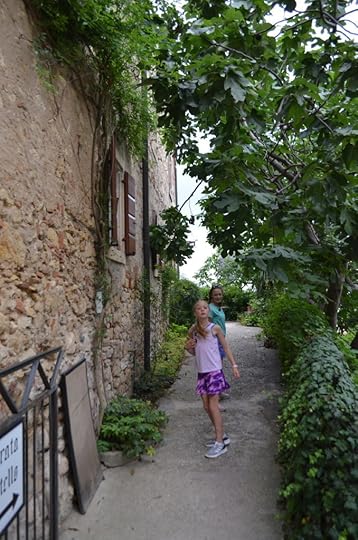
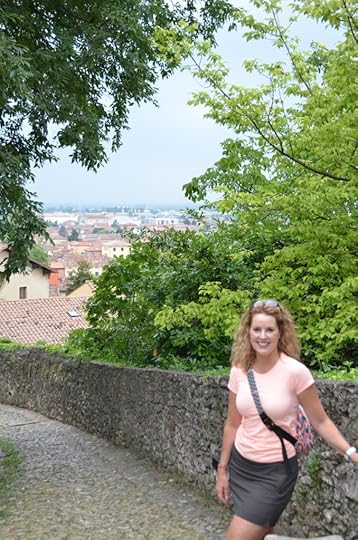
From the caretakers home (left) and the less-than-steep walk from the lower village (right).
Castle Soave
Today, the privately-owned castle has a caretaker who lives on the property in a converted sentry house with his German shepherd. The entry fee for four, two adults and two children was 24 Euros (adults 8, children 4). The walk up from town is short and steep, but not too bad compared to all that we’ve ever done thus far. Once at the entry station, it’s less than a hundred feet to the primary entrance.
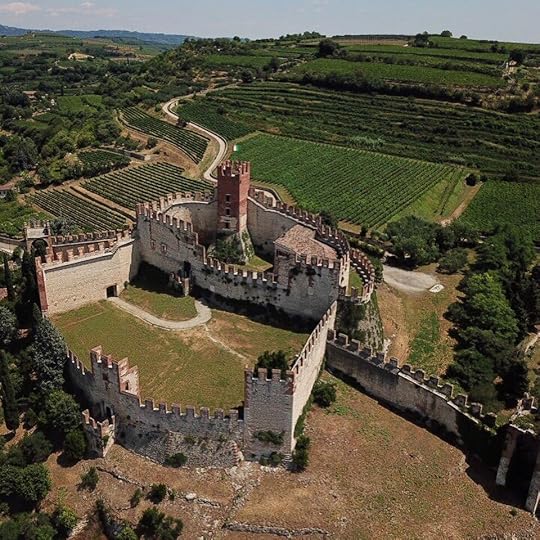
Set on the highest hill, Castle Soave’s fortress walls extend around the town of Soave proper, which is now converted shops and restaurants, although it’s home to several thousand full-time residents lucky enough to live with castle and wine country views.
Why it’s called a castle is unknown to all of us. The lone attendant within the Captain’s private chambers told us Castle Soave was used for centuries a military fortress for several reasons to protect the town from the neighboring community. It was originally built in the 10th century, the twenty-five-foot-high, two-foot-thick rock walls were built around the town to defend against an attack. Within the highest reaches, two floors exist; one for the Captain (the Italian version of a General) and then a lower level, rather small room for the guards. The remaining part of the rampart was all watchtowers and fighting stations.

From this areal view shot by my drone, you get an idea of the size of Soave proper, the fortress wall a clear line of demarcation.
The armory and guards station is rather small, with attendant saying the room slept only five guards at a time. The rest were on duty around the clock. The Captains private floor has four gracious rooms, the foyer, where he received his soldiers and visitors, his table and three-seat bench in front of a floor to ceiling fireplace. To the left is his bedroom, the ornate bed, armoir and facilities far fancier than the Prince’s rooms in Germany and Switzerland. The Italians knew how to carve a thousand years back! To the right of the foyer is the eating area then library. Up the steps from the library is the Captains private garden, a spot of greenery where he could presumably plot his next battle plan. To the left is the escape door which isn’t concealed at all. If the man needed to use it, speed was the factor, not illusion.

This is the Captain’s escape door off his private garden. It’s thought never to have been used. Little factoid: the last Captain murdered the ruling family in cold blood, ruled himself for 20 years, then was killed in battle with the sword. Served him right.
My favorite part
The best part of this inner military area was the prison. Approximately 100 feet high, all capital punishment was conducted in this chamber of death. The top three floors (each with levels) were designated for nastiness (beheadings, dismemberment etc.) and the bottom floor was essentially the pit where the castoffs, sometimes entire bodies, were thrown down. Then every so often, they’d light the fire, but nary a phoenix would rise from those ashes. The tour guide told us that when the castle was opened to the public, human bones dating from the 1300’s were found.

It was a bad day for a prisoner who displeased the ruling Captain.
The weather in wine country
We didn’t know the afternoon rains so common in Switzerland were equivalent in Italy. We were up on the ramparts, looking down to the valley when it started dumping. From the highest rampart, where we walked the Captains private gardens and escape door leading directly out of the castle, down to his entrance, we were soaked through. But it was so warm that our clothes were dry and hair frizzy when we reached the car.

The upper courtyard, and steps leading to the Captain’s private quarters. The door below is for the soldiers who rotated eating and sleeping shifts in groups of five.
With the weather once again cooperating, we walked the streets, enjoyed our second serving of gelato and appreciated yet another town that seems to have been passed over by every tourist, “influencer” and Trip Advisor writer.



The Captain’s private dining room (upper left) the guards rooms (upper right) and the first courtyard leading to the upper courtyard.
What I’ve loved about the area
Finding a castle that’s rarely written about, seeing miles and miles of Verona, the old and new, past and present.
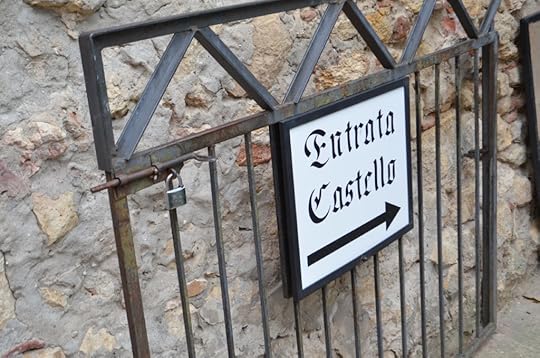
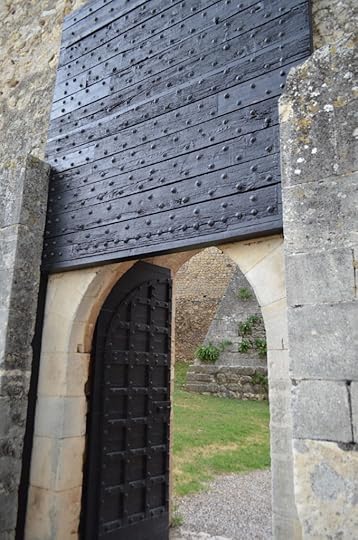

The Castle less-visited: with tourists sparse, no ticketing agent, metal detector or guide. Just walk up to the care takers office (where he sits with his dog on the floor) Upper left. The second doorway has a downgate, not a drawbridge, but includes a standard door for good measure. Me squatting so you can see the better view of the town behind me.
What I haven’t
The bugs! Oh. My. Gosh. Why hasn’t a single person in the history of man written about the ‘no-see’ems’ that come out when the heat of the day starts to ebb, changing from blistering to merely humidly hot? It’s so bad that in the thirty seconds it took to walk from my car to the front door, I got nailed by seven little wizards of torture. When we were at the pharmacy to pick up my prescriptions (from the next blog on the unexpected Italian hospital visit I had to make the second day here), the pharmacist asked if we’d been bitten at all, and we nodded vigorously. She produced a tube of cream that I have carried everywhere for three days, applying to the red dots of purgatory on all of our skin.

Recommendation
You don’t need to be a lover of wine to enjoy and appreciate Verona. It’s centrally located to zip down to Milan, over to Venice and not far from Lake Como. We are headed next to Salzburg, Austria, which is about as far as either Milan and Lake Como at three and a half hours. Definitely plan a few days, perhaps at a bed and breakfast or home to really soak up the local culture.
Feature photo: shot from the village walking up.
An unexpected hospital trip
One of my personal jokes has always involved the notion of being in a foreign land where I don’t speak the language and need to visit the doctor. Well, “We mock that which we don’t understand then we get to experience it ourselves,” as I wrote in my novel, In a Moment. At the time, I was going through quite a bit of self-reflection, but in no way did I think I was going to have a chance to confirm this statement.


Unlike the ER waiting room, the diagnostics area was vacant. Rog prowled the hallways like a lion in the Serengeti looking for snacks at 3 a.m.
Ignoring the pain
My husband calls me stubborn, but I like to think of myself as the anti-whiner. In April, an older Mayan woman gave me a traditional healing massage while we were in the Yucatan peninsula in Mexico. As I was on my back, she pressed on my lower stomach and it hurt. Bad.
“You have stress,” she said in broken English. “No stress,” I assured her with a laugh. Yes, I felt the same knot she pressed, but it hadn’t hurt until she pushed, and I certainly didn’t buy in to the idea stress caused a temporary ball in my gut. Honestly, I just thought my growing tummy was “a woman thing” and I wasn’t going to waste my time or a doctor’s only to be told I needed to eat less cheese. I went home and ton with life, not giving it another thought unless it was for vanities sake. The waistband was a bit tighter, but it was the cheese, right?


Was to cheese or a bad case of indigestion? My brother suggested pregnancy but no.
So here we’ve been huffing it around Europe for two weeks, walking quite a bit. My midsection had gotten a bit bigger, but I chalked it up to eating, that is, until my husband pointed out that wasn’t really eating at all. I had to think about that, and it was true, I’d not been my normal, Sarah-self-of-culinary indulgence. In hindsight, it hurt to eat, so I just ate less. Around the time of this discussion, I realized I’d not been drinking much either, and since I’m a water girl, I’d been developing dehydration headaches. Nonetheless, my goal was to see as much as possible every day and not talk about my innards, which is never a fun family dinner conversation topic.
The crisis moment
The day we arrived in Verona, my body was angry at me. I hurt the entire drive, constantly switching positions in the car, declining food and water, hoping the increasing misery would go away. I assumed I’d been in the car too long, the twists and turns of the road from Bellagio pressing against my stomach the root cause of pain. I helped unload the car and walked up and down the three-story villa Rog had chosen, feeling worse by the hour. Shooting spikes traveled down both legs to my feet, cresting over my hip and down my butt cheeks, but even then, I thought I was tight from sitting. It wasn’t until I stood and my vision became blurred, I could barely walk that my husband called up our doctor back in the states. He listened to my symptoms, including my distended stomach and told me to get to the hospital immediately.


Alien twins never looked so good on a human, at least not at 4.5 months, right?
That was at four in the afternoon, yet we didn’t arrive at the hospital until 10. The intervening hours were filled with Rog boing back and forth with Blue Cross/Blue Shield back in the States. A process must be followed, we were told, the care providers in Italy linked to BC/BS or else we’d get the bill. When we were finally assured I’d be fully covered did we pack up the girls with items for a potential overnight and get on the road.
The waiting room and process, Italian style
Fortunately, Ospedal (Hospital) San Bonifacio was the
closest and newest facility in the entire region.
The waiting room was interesting, because admissions had
one, non-English speaking staff member. I ushered the girls to the only seats
available as Rog waited in line. Through a double door he went, but not before
another gentleman who wanted to cut in before Rog. As I watched the
interaction, I thought about a universal truth: “No,” is understandable in
pretty much any language.
After fifteen minutes, Rog called up Stefano to help translate. As I stood beside him, I nearly fainted. That was the signal for the attendant behind the plexiglass partition to do something more than keep repeating: “No English.” As I teetered into Rog, a male staff member appeared who asked about my condition in thick, but understandable English. Rog explained I might have an abdominal tear, and if the small intestine went through it, the effect could be sepsis. The man immediately requested another nurse to help me back through the doors. I’d made it in!
Slow but thorough
What I got was a gurney, which spared me from passing out. Left
alone for thirty minutes, I contemplated how this was definitely going to end
up in one of my books, assuming it turned out well. All sorts of plots occupied
my mind, distracting me from the pain until the male nurse returned. He asked
questions as he gradually pressed what we both thought were my intestines back
into my gut. If you think that sounds gross to read, it was gross while he was
doing it. Plus, it hurt like the devil, and I couldn’t stop the tears of
absolute anguish as he massaged and pushed around my innards.
My stomach reduced in size about half-way, but I felt quesy.
“That feels better, doesn’t it?”
“Not really,” I grimaced, but at least my belly wasn’t sticking out like Kuwato alien from the original Total Recall movie.
Nearly an hour passed before until I was led in to another
room staffed the senior ER doctor, and a visiting doctor who translated, along
with the original two nurses. The room was set up for triage, but also had the
makings of an office, because a doctor sat at his modern desk, typing on his
computer, the printer behind him periodically spitting out documents.
Once I was laid on the gurney, he spoke, and another doctor
beside me translated as the senior ER doctor typed. Rapid pace, we went back
and forth. All the while, the two nurses went about their tasks, drawing blood
from one arm, the blood pressure from the other, each having their role, moving
quietly, efficiently and without a pause in the flow. When I asked the
physician by my side where he was from, the handsome man only told me he was
from Morocco and I got the hint: don’t make the small talk with the team, let
us do our job.
Questions over, the silver-haired dr rose, coming bedside.
He pushed my guts around, inflicting more pain than the nurse, but with
purpose. When he’d finished, he was back at the computer typing. I was then
informed I’d be going up to receive scans of my internals, which would be conducted
by another physician.
That began a 90-minute wait, half on a gurney, the other half in a solitary area with my family. It was at that point I thought: “Arg! I need to be one of those crazy wanna-be documentarians, because I should have been taking pics along the way.” I took two pics on my iphone then put it phone away. From the discussions that had occurred, I had bigger things to worry about than the missed photo opp of the crammed waiting room.
Growths, eggs and pain
Once the female physician had me lie down, she said straight
up she didn’t see a bulge. That was depressing. Was I that fat she couldn’t
discern the alien bump protruding straight up and out of my belly button?
I wasn’t going to debate the bump or pain, and just told her
what the previous doctors said. She whipped out the topical goo, spread it on
my stomach and ten minutes later was on the phone with the supervising ER doc.
She’d found two, egg-size tumors in my stomach, although she was quick to point
out that it be unknown if they were benign or cancerous.
The next stop was back to the supervising doc, who
personally escorted me, Rog and the girls three floors up to the gynecologist.
This older man was very refined, and I wanted to compliment him on his choice
or colored glasses and cool watch, but I was a good patient and kept my mouth
shut. (Readers of my novels know this was hard for me because I have a thing
for watches and glasses, sometimes calling them out too much).
He did the full-monty exam on me, politely inquiring why it
had been three months since my last exam, then following up his question with
dismay that in America, ultrasounds on females during annual exams aren’t
required. Here they are. Had I had one, my tumors might have been caught when they
were much smaller. Now major surgery might be required.
After he’d remeasured and reconfirmed what the prior Dr. had
found, he went a step further, telling me all about the myomas (tumors), the
percentage that were cancerous (1%), the “nasty infection,” I had because they
have been seeping toxins in my body, and the reality I’d be in ongoing pain and
wouldn’t be able to eat or drink much until the surgery occurred.
“What do I do about the pain?” I asked him.
He blinked. “Take ibuprofen.” When I started laughing, it was one of those bordering-on-hysterical sounds that break glass and kill relationships. “Maybe I can give you something stronger.” It wasn’t until I filled the prescriptions for both infection and pain that he’d prescribed a granulated mixture of Ibuprofin plus something extra, but since I don’t read Italian, I’ve got no clue. All I can tell you is the moment the liquid hit my tongue, it went number. I have a pack of 60, which I keep on me at all times.
The finish line
Back down we went to the ER doc. By this time, Rog had
gotten him chatting about motorcycles, and I believe when the man realized us
American’s weren’t going to stop trying to speak bad Italian, he started
speaking pretty good English! I suppose in the first few hours, he suspected I
might be in and out, therein using the other doctor to speed up the process.
Now that I’d taken up the majority of his shift, we learned about his travels,
his love for fast automobiles and what in the world I was going to do now.
I thought I was all done when the nurses reappeared on cue,
and IV was set up and one told me it was pain medication drip, which would also
help with the dehydration.
The ER doctor sat at his desk, which was actually located at
the end of the patient’s room where most of this took place! Nothing like
Italian efficiency. A printer was behind him, he did all the computer work
himself, and at the end, while Rog kept chatting him up, he assembled the
documents and scans from the ultrasound, stapled it and asked Roger how he’d
like to pay.
Rog stopped cold, like the blood in my veins. Wha..wha…?
Beyond the fact I’ve never seen a doctor do all the paperwork, a printer in a
trauma unit and using a stapler, he was ready to take our money. Then we braced
ourselves. Rog accepted the documents with the grace of a rat facing a viper,
rather tentatively. He stared, I waited, the doctor was already working on his
computer again.
“It’s 117.62 Euro,” Rog repeated, as if making sure it was
correct. The doctor nodded without looking up. “Cash or credit?” was Rog’s next
question.
And that, my readers, was the shock of the world. Not that
I’ll need surgery and egg-size aliens making me look five months pregnant.
Nope. It was the beauty of socialized medicine. Just the admittance alone in
the states would have been @2K. Add on that all the doctors, the tests, the
procedures, and we estimate the bill in the US (pre-deduction and insurance)
would have easily been in the thousands.
Roger paid, and the man physician handed me the entire set of paperwork. Then, in the ultimate of wonderful gestures, he walked us to the emergency room and out the front doors. Where in the world does this happen at a medical institution where the commoner (us) doesn’t have the last name Bezos or Gates, and certainly hasn’t gifted the place a new wing. I’m not sure the $117.62 Euro was the reason; I believe this is standard Italian protocol; professional to the very end.
The best part was yet to come
You can imagine my relief and distress on the drive home. Forty-thirty in the morning, the family was wired and hungry. We stopped at an all-nighter restaurant and had pizza. Well, they had pizza. I watched. The next few weeks were going to be brutal if the doctors were to be believed. But going home ceased being an option when I realized I wasn’t at risk of immediate death; this was money spent and time allocated. No way was I going to ruin our vacation. I was just going to follow the gynecologist’s wisdom and essentially suck it up.
That night, I informed my mom and church leaders of my situation, asking for prayers, and that’s when the miracle happened. I woke, expecting the brutal pain, and had none. We weren’t able to fill the prescriptions for another day; each and every hour I braced myself, believing my body was going to revert back to its state of the prior day.
It never happened.
Rog didn’t believe it, nor did the doctor on a follow-up call, but I did. Mom and telegraphed my request to all the family members on both sides, aunts and uncles, children and down the line, the equivalent of the mayor calling the bat phone. The church leaders did the same. The prayers of many were felt by the one: me. It’s now day three. Instead of lying on my back, I’ve been able to walk. No, I can’t eat solids, because that causes immediate pain, but I can drink limited juice and sip light soups, which is a lot more than I could previously.
There was another thing. What we initially thought the time lag in getting to the hospital was a detriment was a blessing in disguise. The Moroccan doctor would not have been on staff, nor the senior ER physician or nurse who got me in so quickly, because they worked the 8-8 shift. Had we come earlier, who knows what we might have encountered? Further, the gynecologist said this was his single night of the week when he worked. His perfect English, and ability to conduct such a thorough exam and to equip me with knowledge and a path forward calmed my fears.
Although I’ve been joking with Roger that this is my version of a European fat farm, (because I’ve been wanting to lose twenty pounds for the last four years), what I’m really thinking is that God knows I exist. He cares for me. He answers the prayers of his children. That I am loved.
So instead of asking ‘why did this happen to me?’ I thank God for the experience and the little blessings along the way which made a hard life moment a little easier. Most of all, I’m grateful for the affirming power of prayer and His ability to answer.
July 11, 2019
Bellagio, Lake Como
As we hit the hills around Lake Como, the longer switch-backs now single-lane, curvy roads requiring a whole lot of skill to avoid either rock wall or another automobile. Now that we were officially out of the Alps, into Italy, I downloaded the photos of the Alps onto my computer and started fresh, as is my protocol, then started a new.

Shortly after crossing the border from Switzerland to Italy, this fixture on the horizon appears – and you know you’re in Italy!
Lake Como
The size and scope of the lake usually takes first-time visitors by surprise; Menaggio, Lugano and other inlet towns dotting the lake have their own unique vibe and attraction. We’ve gotten to know each more intimately during our travels, which changes if looking through the lens of having teen and pre-teen children in the group.

The waterfront road in Menaggio; wide, relaxed and the vibe easygoing.
Menaggio is the first town you will reach, its small waterfront area having a street or two of shops, as well as restaurants. One of the four ferries used for reaching Bellagio is in town, but be warned; the ferries only allow about eight cars, so you will be waiting an hour if you don’t get your place in line. My favorite aspect of Menaggio is taking the short walk (or drive) nearest the ferry because the waterside villas are massive, ornate and the grounds worth writing about. In my novel, A Convenient Date, Rick and Kaitlyn are in Switzerland for a business meeting, have a free day and he takes her to his childhood home in Lake Como. A few of these photos are the ones I used to inspire my descriptions. During that original trip, I neglected to take photos, but this time around, I did.

The villa directly across from the ferry in Menaggio
Lugano, further down the lake, is larger, the residents
spread in the hills and has a denser downtown area, yet because of that, it
loses a bit of the small town feel. On the upside, it has fabulous high-end
shopping at half the price of Bellagio, so unless you want to say you
specifically purchased your Hermes in Bellagio, do your pocketbook a favor and
purchase it in Lugano.
If you are a first-timer, check out Rick Steve’s commentary on which city to visit first, and how to get there from your starting point.

Notice the slight difference in road width from Menaggio vs Bellagio? The above is a typical road in Bellagio, and what my daughter is doing was what all pedestrians must do–hug the wall so as not to get clipped by a car.
The scenic route around the lake or the ferry?
Once we decided to explore the lake and drive around the southern tip in order to reach Bellagio. That was a hair-splitting four and a half journey we’ve not made since. The ferry ride for 4 in a car was 28 Euro and took ten minutes, which we learned on the return ride after we’d spent the day on the peninsula (which is how Bellagio is typically called).

Lake Como from the sky as we took the ferry ride to Bellagio.
Today, we were second in line for the ferry, allowing Rog to send the drone up and over to our intended destination, and me and the girls to chat up a wedding party of girls. Sometimes, ferry’s with short rides don’t allow auto passengers to get out. This one does, and we took advantage of no-rule rule to walk around.
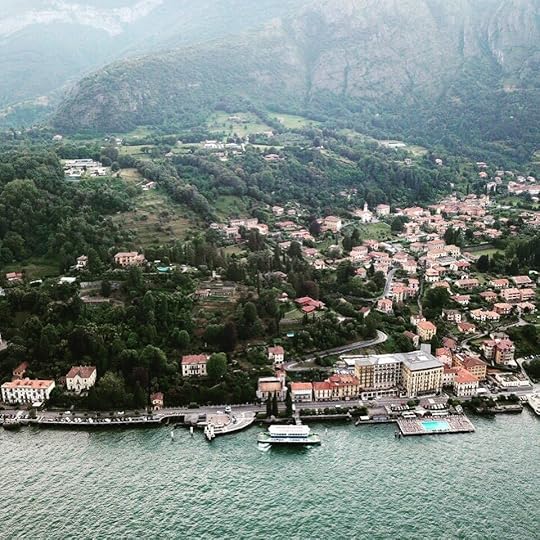
This is a view of Menaggio from the air. We shot it while waiting for the fery, which you can see is docked about mid-way in the photo. the villa I used as inspiration is right behind it.
Parking and walking off the ferry all happens in the same area, providing you with options. To the right, can walk down the quarter-mile, two lane white gravel path to sit under the blossoming white and pink trees nearest the water or on the grass, the shade provided by massive beech trees. City architects have made this picture perfect, as the center islands area bunches of colorful flowers and half-circle walkway extensions over and into the lake allow for the perfect pictures of either Menaggio in the background or the Bellagio center. This ends at the entry point of the expansive Giardini di Villa Melzi, and if you want to reach the other side (where our flat was located/the market square for locals), its faster and flat. Otherwise, you are walking on the road, up and around, taking your life in your hands.



Three views of the walk way going in to Bellagio–all taken from the perspective of the
Giardini di Villa Melzi

A large villa overlooking the town of Bellagio and the main square
Bellagio proper
Now that we’ve been a few times, Rog and I have a different perspective than the first time. Whereas we were overwhelmed with the quaint main center, steep paths leading through the narrow buildings, gelato and shops, we now realize something so obvious it’s a little embarrassing to admit. The “picture-taking-tourist-zone” consists of literally two roads, two steep paths and the waterfront path I just described. It’s basically a big U-turn you are going to walk. These are relatively crowded, everyone with a phone in hand, taking selfies, eating gelato and buying scarves.

The shops close at 7:30–this was taken about 8:30 p.m. The restaurants are still open, but gelato and all the other stores closed. It being July, the crowds were manageable. That won’t be the case in another month.
We watched (and then did it ourselves to revisit our first experience) tourists disembark from the ferry. Instead of turning right, you turn left of Via Lunga Lario Manzoni and begin your exploration of the inner Bellagio. If you are following a map, continue on Via Lunga Lario, and assuming you have the strength not to imbibe on pizza or gelato, take a right on Salita Serbolloni, and up you go until you reach Via Guiseppe Garibaldi. This is the only road paralleling Lunga Lario, and it’s a T. You can go right, but the shops end about fifty feet down. The only course is to turn left, enjoy the tiny wine, meat or cheese shops, pause and take a picture at the most crowded place on the peninsula (because looking down, the image offers both narrow street at the lake beyond). After that, you turn left down Salita Bento Conzi Di Cavour, the second steep steps and you are right back on Via Lunga.

Yet another villa on beautiful Lake Como.
From there, you head back on Piazza Giuseppe Manzini. This is the same road as Via Lunga; the reason for the name change is that shopping districts in Italy are have the name Piazza in the front as the designation to identify it’s about shopping. Awnings extend from the buildings which offers a welcome relief from the heat of the day. Tables are set closest to the street but still under the awnings, the pedestrians walking between the tables and heading into the shops. Yes, we’ve purchased leathers and watches in Bellagio, because some good deals and lovely items are to be had, but we know when to wait and when to purchase.
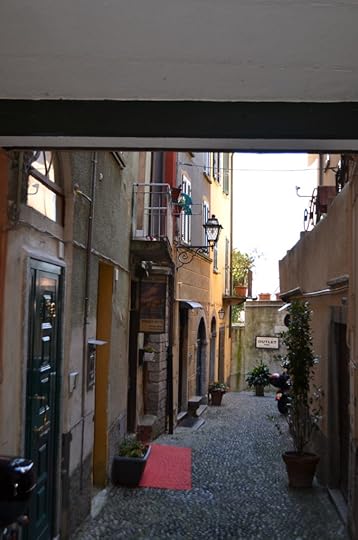
The narrow path in Bellagio less traveled. This is totally common outside the “U-turn” as I call it.
The real Bellagio
No, not really. Bellagio offers many more restaurants and shops, but the truth is that tourists are usually walking and don’t bother explore either.

With the two main hotels a hundred feet from the ferry, and waterfront restaurants, you can literally spend your entire time within about 5,000 square feet of the Hotel Excelsior’s front door and be completely satisfied with your trip to the famed Bellagio shops on Lake Como.
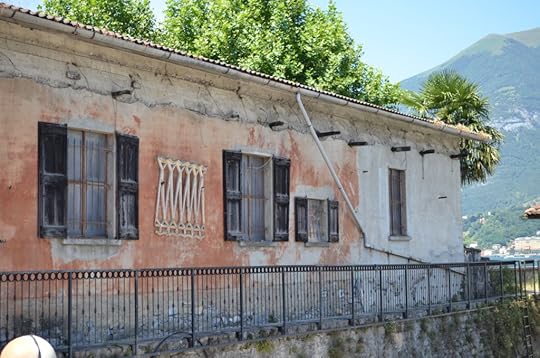
This building is adjacent from the marina above, one of the many hidden marinas not far from the glitzy Via Lunga, but taking a few side streets open up the gems of every day Bellagio.
Ever the contrarians, we went for the anti-Bellagio experience this time around. We rented a top floor flat in a Bellagio neighborhood full of locals about two hundred feet from the waterfront, about half a mile from Bellagio center. This required we walk through tunnels, up and over bridges, using the 700-year-old lanes so narrow I could touch the rock walls on either side when extending my arms.

Unless you want to pay 10 Euro to walk one-way through the Villa di
Giardini di Villa Melzi, you will be walking on the road to Bellagio. This is about 1/4 of a mile from the center.
Butcher shops in a space no bigger than bedroom at home provided hand-cut prosciutto for our breakfast, a kitchenette size restaurant in an alley filled served diners on metal chairs and a table the size of my lap, all that was needed for two plates and lots of wine glasses. Laundry hung two and three floors above us, out of sight until we looked up, hearing the squawk of birds. Three babies in a nest were being fed by their mom, which made us wonder about the cleanliness of the clothes hung out to dry. It doesn’t get much more real than that.
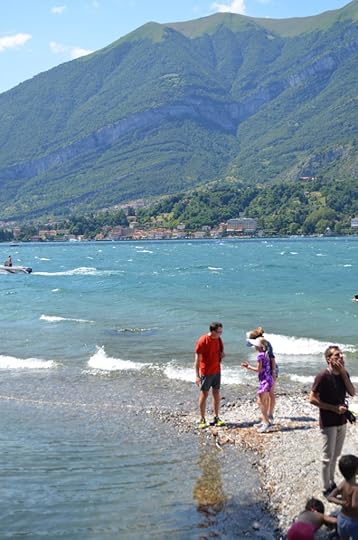
One of the many inlets we found simply by wandering our neighborhood in Bellagio. The water was brisk but swimmable–the wind invariably picking up around 3 p.m.
Marinas and waterfront bathing
One of the appealing aspects of renting a unit like we did was the community “square” right down our street. We’ve found so many squares in Italy are based either right of front of, or nearby, a large church. This held true in Bellagio. Our first night was punctuated with the sounds of a big party. We unloaded then went exploring.
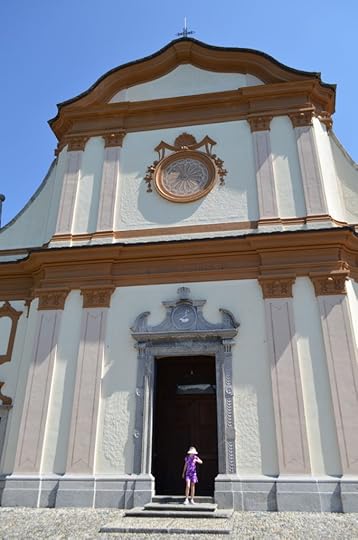
The community church near our flat where the party went down!
Sure enough, in front of the church was a basketball-size square, with community tables set up and a massive buffet-style offering. A band played regional music on a temporary platform, the tanging white lights straight out of a movie set. As the adults drank wine and engaged in lively discussions, teens lounged against the thick, stone perimeter of the marina below. It wasn’t exactly ideal for our girls, but was fun to take in and experience.


This lovely beach is free (as all the hidden ones are free vs for pay elsewhere in Italy), and has an eatery steps away. Another area found by walking around.
A bit more walking (about two minutes) and we discovered a connected area of sloping gravel and pavement which had a t-shaped dock attached. The following day, we returned to find the area sparsely populated, even though it was about 95 outside. Our girls jumped the dock, then followed the locals by hurling themselves off the high rock walls in to the lake.

More steps! A short cut connecting the waterfront, local road to the (only slightly) wider road used by cars above.
Later in the day, we continued our waterfront journey, discovering multiple inlets where the water from the mountains met the lake. These were usually alongside villas hidden behind dense shrubs, but we saw enough of the bamboo trees and glistening blue water to appreciate the property.
Our favorite places
In Bellagio, we’ve had gelato from every shop in the main area, and yes, we do have our favorite. It’s under the Hotel Excelsior right on Via Lunga. While it’s .50 Euro more than anywhere else in the main area, the store also offers a broader selection and bigger serving sizes. Right across from this store is a marina equivalent, owned by the same company. The portions are smaller, same price and not as firm (as in, almost runny gelato). I know this is getting in the visitor weeds, but some people pay attention to, and care, about the little things.
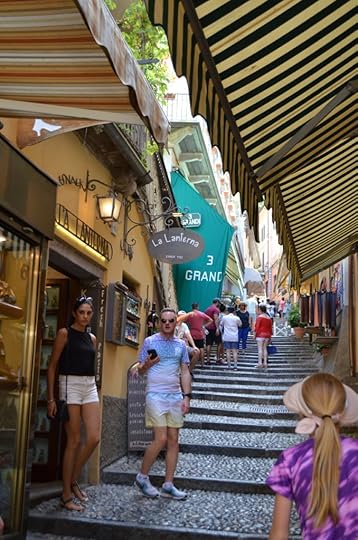
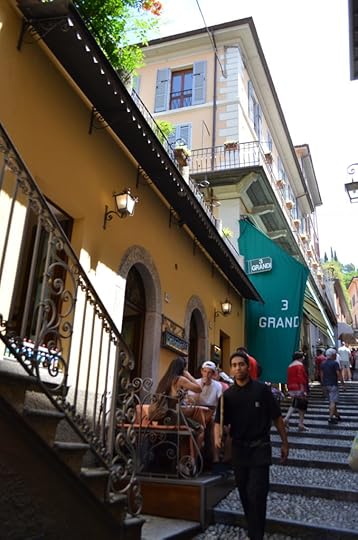

Our favorite eatery…
Our favorite eater isn’t one of the waterfront restaurants. It’s on the first and most popular path the tourists take, including ourselves years ago. We love it for the homemade soups, massive meat and cheese plates, bean soup, and pastas. Despite our intention to branch out and not go here, no matter what we do and where we eat, this is our version of the pilgrimage to mecca. We can’t come to Italy and not go to this little hole-in-the-wall restaurant.

Another local hangout- I shot videos of the girls jumping off the end of the rock pier. They figured if the locals could do it, they could too.
Making friends
One of my favorite elements of traveling is meeting new people. This is Svetlana, who was in front of us at the gelato shop with her dog. She’s from St. Petersburg, Russia, staying in Bellagio for the summer with her boyfriend, an art dealer. She was adorable, and of course, had great skin which she covered under an enormous white hat.

My new friend Svetlana, a beautiful woman inside and out.
This other side of Lake Como
Leaving for Verona, we took the direct path, which in reality, means the single lane, lake-hugging road. And when I mean single lane, that’s not one lane both ways. It’s actually a single—one—lane. Cars going either direction share it as best they can at speeds one can only describe as uniquely Italian. Turn outs are rare, buses are common, and it was a torturous hour to reach the other side. Once there, however, the pace of traffic slowed, the buildings, while less pretty, more functional and crammed together along the waterfront, wasn’t a turn off. In fact, we thought this was the where “the real people,” of Italy lived and worked rather than on the well-known west side of Bellagio.
Important tip for parking
If you are going to drive a car and rent a place with parking, be sure to dig for details. While our flat had parking, what the owner didn’t identify is that the 800-yr. old, single lane road was barely wider than my arms spread apart (we checked this). The Fiats, Volkswagens and other mini cars could barely make it through, and at the end, the parking was in fact, plentiful. Probably is we are driving a touring wagon, and it’s as wide as a normal car. We ended up parking a quarter mile away at a park, but only after we dropped our luggage by the entry to this small lane, and hoofing it like college students on a weekend getaway down to our place. It was an unpleasant surprise, but in our lives, we’ve never encountered this before. Lesson learned; ask about the proximity of the parking to the unit, and width as well!
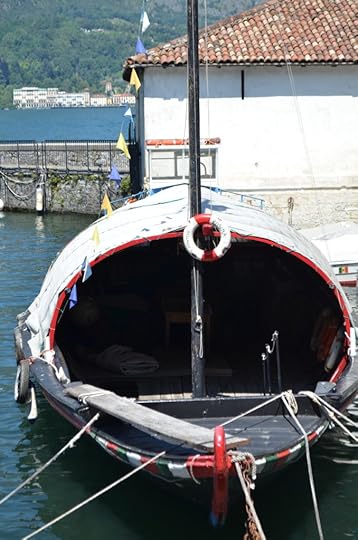
I just love this photo- the boat reminds me of a massive whales mouth that will absorb everything in its sight.
Feature photo: a view of Bellagio from the drone as we rode the ferry
July 10, 2019
Driving the Alps from Switzerland to Italy: Furka Pass & Gotthard Pass
Leaving Thun behind us, we were no more than a mile or two outside the city, on the windy road alongside Lake Thun before we started seeing a handful, then groups, then dozens of street bikes zipping by us, coming from the mountains in the distances. We stopped at Lake Thun to take a few pictures, test the water and grab a bite to eat, but we were being chased by storm clouds. They were already brewing beyond Oey, and by now, we knew the routine. If we were lucky, we had two hours before we’d get dumped.
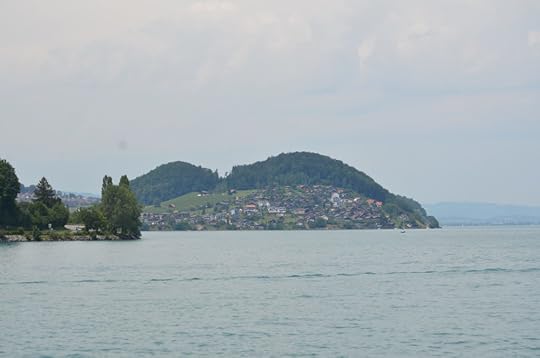

Two different views of Lake Thun as you head towards the Alp passes. Lakeside eating, swimming and skiing all set in the world’s perfect location.
Scenery admired, pictures taken and more bread, cheese and meats eaten, we got back on the road, heading towards the skyrocketing peaks of the Alps. Grass fields replaced apartments and homes, trees giving way to grey rocks which appeared soft from the road. The number of streams and waterfalls grew with the size of the mountains, and at first, I insisted we stop at every waterfall. After the fifth, I realized taking a photo of every water effect coming off the Alps was unsustainable, plus, it would probably be boring to you, the reader.

Never one to disparage a good water effect, but this was the seventh in about a five-mile stretch and I had to put an end to the madness that I knew would befall me when trying to pic “the perfect shot,” for the blog.
The glaciers and restaurants
By the time we reached the top of Furka, the mist had turned to rain, and anyone on two wheels instead of four were in trouble. Then came the hail. I was seriously disappointed because the glaciers were now half-cloaked in grey clouds and my camera was pelted as I took photos, but I wasn’t the only one.

The windy, narrow road of switchbacks, underpasses and overhangs has multiple turnouts for stopping and snapping, or as we found, resting. These hardy pedal-bikers who have the stamina to climb for hours paused, stretched then got right back on their bikes, ignoring rain and hail, soldering on. It was impressive to say the least.
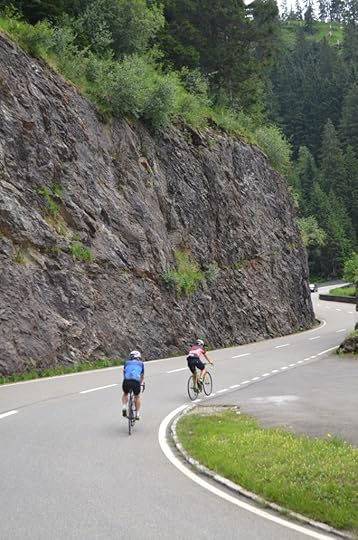

Riding on two wheels instead of four is impressive in my book; hills and sleet are dangerous and not for the faint of heart.
For those wanting a warm drink, a half-dozen eateries dot the road, all with indoor and outdoor seating. Although the rain was coming down, it was still quite warm the entire time, all the way to Gotthard Pass, which would take another hour to reach.



Two different restaurants along the way to Furka Pass, but both enticing to the worn out and presumably weary riders. The bottom picture is a very bored looking woman in front of her chalet, which is located directly across from the restaurant in the upper right.



My favorite Swiss cows–so soft and fuzzy, lounging just a few miles below this dam.
As we reached the top of Furka, the rock formations changed yet again, then it was suddenly green as we began a descent to the high valley. Here, we took a thirty-minute break, darted inside the eatery, waiting for a break in the storm before heading down and out on a peninsula to take a family photo. The rain momentary stopped, we snapped in the high winds, Porsche started singing in front of the fields while I recorded her and then bam. The rain came thundering down and we were soaked by the time we completed the short run to the car.

Descending into the town of Wassen
Through the high valley we drove, enjoying the town of Wassen, it’s church in the center of town and the gelato. Although we wouldn’t reach the Italian border for another hour, Swiss-German had ceased to become the primary language, Italian was now dominant.


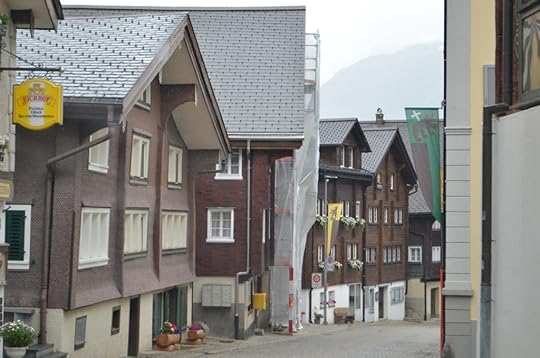
Very quiet at this time of year, save for a few hikers who were in the outer lying areas, presumably staying in the quaint hotels located in Wassen.
Gotthard ski resort
We’d expected beauty and grandeur, tunnels and turns, but not the development of the town of Gotthard, near the top of the pass but not quite. What used to be a few moderately sized buildings in what I’d describe as a punchbowl community, encircled by high peaks, is now a Whistler-style hotels, connected and imposing. While the two areas are being built around a courtyard, and not far from the gondola, it’s still disheartening to see the transformation of the area, but such is life and progress. The train goes right to the center of the development, and for the thousands of ski buffs making the pilgrimage, ourselves include, it’s nirvana for residents of two countries on either side; Lake Como or Thun, Bern and Lucerne.

White and craggly, the rock formations change with each pass.
Up and up again we drove, then suddenly, the sign for Gotthard Pass announced we’d arrived. Our car identified it was about 50 degrees but dropping below 30 with the wind and rain. I donned Roger’s coat, grabbed my iPhone and recorded a short video for Instagram.
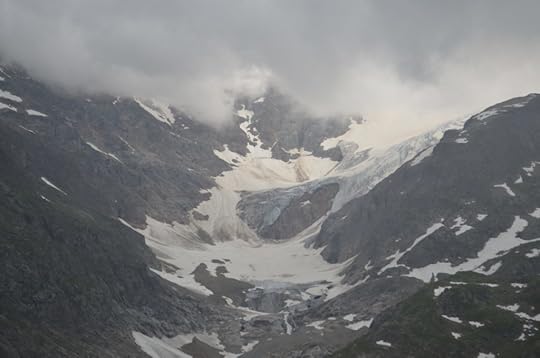
Just before reaching the highest part of the pass, the glaciers appear then are gone just as quickly.
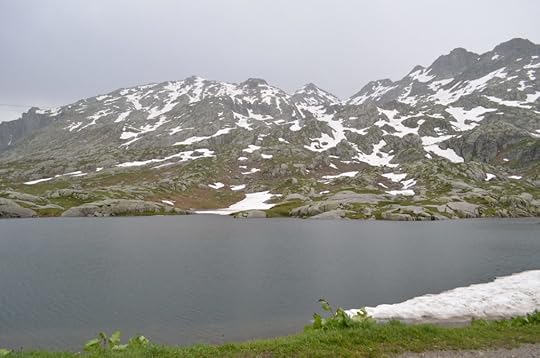
The absolute highest part of the pass where I jumped out of the car, shot the video and jumped back in.
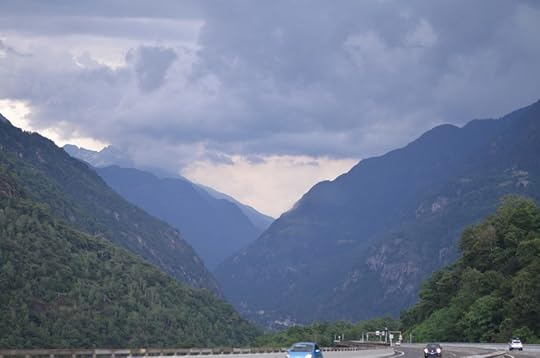
Now going down and down…the clouds are still following but we outran them!
July 9, 2019
The Castle and Canals of Thun
“What a strange choice,” Rog remarked when I suggested we zip through Bern and Lucerne in order to spend more time in Thun. But when I showed him the pictures, he was in. Thun (pronounced tune) boasts a lake, canals, a castle in town, and another three on Lake Thune, Schloss Oberhofen, Schloss Spiez and Schloss Hunegg. Beyond that is another lake at the base of the Swiss Alps. What’s not to like? Thanks to our VRBO rental in the town of Oey, Thun was only a thirteen-minute drive.
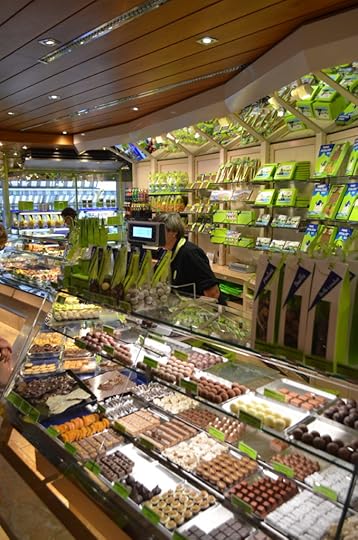
What upgrades a standard street to a culinary mecca? Handmade chocolates, that’s what.
Lake Thun is large enough to boat, sale or swim, and the inlets have perfect glass water for slalom skiing. Homes, hotels and eateries, formal and casual dot the lake itself. It’s far smaller than Lake Coeur d’Alene in terms of length, but is wide and dramatically set in the basin of the alps.
Our first stop was downtown, where several parking structures are within two blocks of the canals and main shopping district. For a few hours is about 10 Euros, the walk through one main lane, across a canal, then another lane, another canal and then you are at the base of the Castle Thun. Be prepared to take multiple shots of both canals and streets, and the best picture of the castle (if not from a drone) is off the canal-road. Straight up and click.

One of three consecutive stairs. You can barely make out the steps due to wear over the 700 years. Slippery as all get out, even when dry.
Then you are off to the stairs the Castle Thun. You can take the uncovered set, or you have a choice of several covered with wood, reminding us all of a medieval movie yet to be made. Old, craggly stones and even older arches above us got us talking about the townsfolk required to make the pilgrimage up the up the stairs.

Entrances to castles dramatically vary, from grand and imposing, to efficient, short or long. Castle Thun’s entryway was in between, on the shorter side, solid but not overly grand.
Nearest the castle are several enormous mansions under reconstruction, the sweeping views and majestic courtyards nearly (or some more so) impressive than the castle itself.

Although the armory is closed off (e.g. non-existent any longer) a few pieces are placed in the small courtyard. Not pictured is a small café to the right of the cannon.
Castle Thun is rather small and unfortunately, a tad stark. My girls called it straight up boring, but that’s all about perspective. It’s been turned into a museum, so if you compare it to the three other in the region, yes, it’s not going to over coats of arms, silver-embroidered dresses or canopied beds of the other castles we’ve toured. The purpose of Thun Castle is to highlight the history of the town, and rotating exhibits. Even so, the walk up is worth the effort as the panoramic view of the Thun is lovely and the descent options of the covered and uncovered, narrow walkways are completely unique to this city.
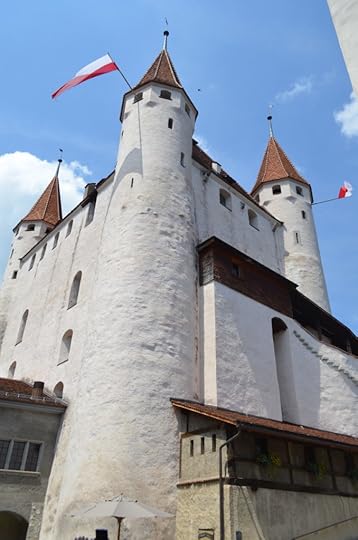
The shot up from the main courtyard. Much of the castle has been turned into a museum, making the outside much more interesting than the inside–for kids, that is.
The Canals
What is pure European would cause heart attacks in the US. Multiple bridges, a quick moving river, men, women and kids jumping, diving and backflipping off the bridges, heads ducking under the lowest bridges, then popping back up, eventually trying to get to the side of the final swimming area or get smushed against the grate at the very end of the canal, where a very placid “lifeguard” is on duty. All in full view of espresso-sipping watchers eating paper-thin crust pizza, usually a cigarette in hand.
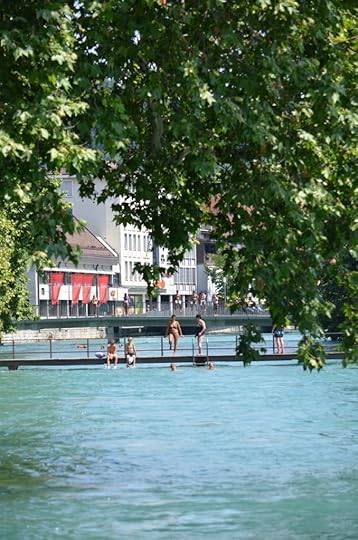
A sight never to be seen in the US–jumping off higher, medium and low-lying bridges, no age limits, no rules. Just fun.
When Rog and Porsche returned from a grocery run, returning with tails of kids and grandmas hurling themselves of bridges, we were skeptical. The water had to be too cold, too dirty and an anomaly. Let me assure you it was anything but. The city charges a fee which is given at the formal swimming/grate area, for I’m not sure what else to call it.
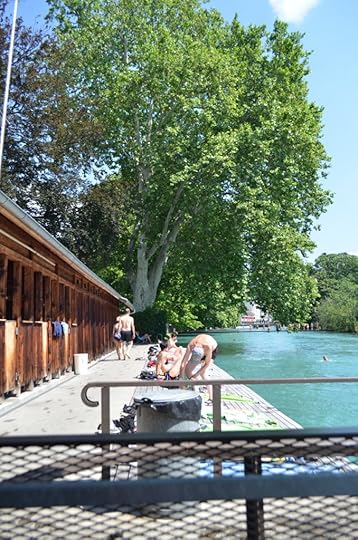
Canal-side sunbathing, dressing rooms (unisex and as you can see, open above the waist.
If you don’t want to end up at the very end, you can jump off further upstream, then swim to the side of the canal and pay no fee. However, the end of the line if you will has changing stalls, washrooms, a café, slide and upper deck on an island separating both canals. It’s just a bit nicer than getting out on the grass—but here, the Swiss don’t even want your feet to get dirty. If you desire to save the 7 Swiss Francs, concrete steps are on the side of the water so you don’t slip in mud. How civilized!

In between the two canals of Thun is this main street where pedestrians own the territory, shops are plentiful and goods are relatively reasonable (for Switzerland, that is).
One night, Rog and I left the girls with the farmer’s wife and children and had a dinner on the canal. It was low-key and romantic, the neon lights of the restaurants on the other side classy and demure, unlike the canals and lights in Amsterdam, if you want a comparison. Here, the tenor during the day even in the shopping district is relaxed and slow-paced, although fun and upbeat. Certain towns have a vibe, and Thun is one I’d describe is calm and happy. We just adored the two days we spent exploring the inner parts of the city, as well as the lake side area.

Both sides of the canals in Thun are equally beautiful, offering many eateries of all types.
What I liked best
Thun is easy going, from the driving to eating and recreation. We chose not to visit the several large swimming pool/areas because the lake was surprisingly warm and it didn’t take long to realize we could have spent two weeks in this one town and surrounding area of Interlaken and still wouldn’t have seen a tenth of what the area has to offer.

Tree lined, gravel walkways line the canals of Thun.
What I liked least
Knowing that when I return home, I’m going to feel a slight depression that nothing we have is as well taken care of, protected and preserved as it is here. The Swiss are so fastidious, whether it’s the backyard, the pavement of a tunnel, or the common parking space, the grounds, walls and surfaces glisten. No graffiti, not desecration of public space; its divine.
Recommendation
Book more than four days in the Interlaken area. We had five and wish we would have had ten. And this blog only covers the town itself, not the Alps!
Footnote
“Thoone? Toon? Thune? How do you even pronounce that?” Rog asked aloud. By the way, the name Thun is pronounced ‘tune,’ as in, singing a tune, we were informed by a local, making it clear we weren’t the first and won’t be the last visitors to woefully mangle the town’s name.
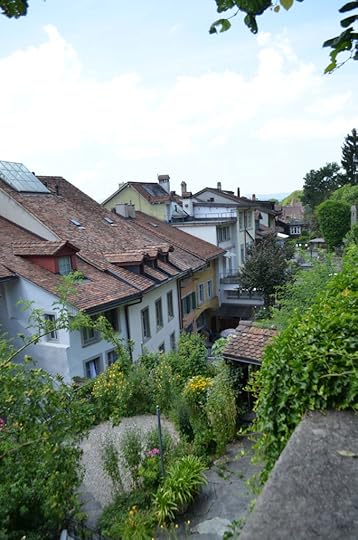
View from the top of the stairs, just below Castle Thun.
Feature Photo: downtown on the canals.
Five days on a Swiss Farm
Not many people know that for my 50th birthday, I asked Rog to find us a place that was local (e.g. didn’t require a plane flight), unique (something we’d never done before in two decades of marriage) and not a lot of money.
“The impossible, in other words?” he asked. Pretty much.
When Rog came back to me a few weeks later, he was grinning
like a Cheshire cat. “I don’t want to tell you, but I’m worried you’ll hate it,
so as much as I want it to be a surprise, I have to tell you.”
Good thing I was sitting down, because he’d booked a newly-built farmhouse on an eco-farm on a hillside in Nelson, British Columbia (blog forthcoming). It’s owned and run by a Swiss family who’d emigrated ten years prior. The farmer had taken over a ramshackle, one-hundred-year-old home, remodeled it and proceeded to create three, descending ponds, create four garden plots, raise cows from which the wife made butter, cheeses and milk. The experience was so completely odd and wonderful, Rog felt that for this year’s trip, he’d do us one better.
“I found us a 500-year old farm house to live in!”
Wow. Didn’t see that coming.
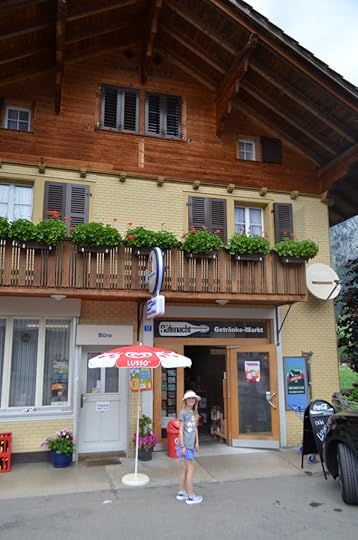
The local market across from the rail line in the town of Oey, Switzlerand (the market was actually 100% alcohol, but then when one is stepping off the train after working in Bern or Thun, I expect a good stein is what people crave.
A day in the life
Located in the town of Oey, the Familia Herrman Farm is a working farm, which means they live on the output of eggs, veggies, milk, cheese, composts (jams) and other items they produce. The farm has been in the family generations, and is now run by the farmer, his wife Annagret and twelve-year-old daughter. A woman in her mid-twenties had a week off of work for summer break and answered an ad to help out during berry season. During our time, it was lingone berry season, so in addition to the daily routine of waking at 4:30 to be in the garden picking, pruning and cultivating, Annagret was also making jams.
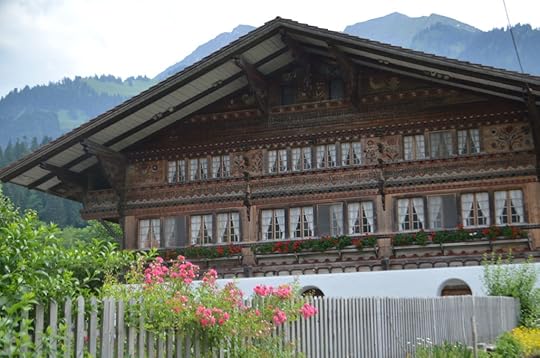
Five hundred years old and looking sharp.
Of the three-story building, our temporary residence was on the top floor, about two-thousand square feet with three bedrooms, a living area, kitchen/dining room and single bathroom. One thing I need to remark about the Swiss, Germans and even Italians—one bathroom to three bedrooms is the norm. That said, the tubs are seriously long- my 5’ 10.5 frame can lounge out toe to head in each bath.

Like many Swiss homes, farm or not, a breezeway dissects the main residence with the outer building, which can contain anything–cars, shop, equipment etc.
Factoid: The Italian influence is felt across the
country of Switzerland. Below the arches or above the doorway on the outside of
homes is usually the inscription of the family, and its always Familia first,
followed by the name of the family.
As we were going to bed at one or two in the morning, Familia Herrmann were up with the sunrise, working until about 11, when Annagret would make breakfast, usually of bacon and some divinely smelling concoction that made our mouths water. The rest of the afternoon was spent indoors, or in the pool to escape the sun. It’s been very warm during our day, the temperatures in the high eighties and one day the low nineties, which is uncommonly hot for this time of year—early July. Those temperatures are usually reserved for a week or two at the end of August.

Another element of Swiss architecture is the use of covered walkways, this one comprised of apple trees trimmed to grow in a linear fashion, up and over the path, to the tree.
My girls helped collect the food from the garden that fed the goats, gather the 80+ eggs from the two chicken coops, played with the dozen or so rabbits and lounged with the two cats. While none of these acts are individually extraordinary, what we wanted them (and us) to see is the day-to-day authentic living of a family, on a farm, in Switzerland. The twelve-year old worked as hard at her prescribed tasks as her mother and father; each contribution vital to the good of the family.
I took to walking morning and evening, doing a loop that was realllllly long and uphill if I went in one direction or short and downhill if I went the other. You know what my lazier self-wanted to do, but the pragmatist in me realized my pants have been getting tighter, so I went counterclockwise to fight the battle of the bulge.

After the daily showers, snails come out with army-like precision, huge and small. We were in awe this little guy went up a six foot apple tree, out the branch to dangle on the leaf, which, by the way, I nearly ran into face first.
One thing I did have to watch out for was the afternoon storms. About 2 p.m. every day, the dark clouds collected, quickly covering the mountains with a dark charcoal. The cracking sound preceded the thunderstorm then the heavens released its watery load. Pellets of rain, hard and furious, drench the entire area. Between the heat and high velocity rain storms, it’s no wonder this region is so blessed with the bounteous crops.

One of four gardens run by the Hermann familia.
Factoid: Horseflies come out at night, along with these uber-sized flying beetles. With the setting sun and cooler air, these wing born carnivores seeking human blood hover near the green fields, and if I walked within about five feet of the fence line, I’d get attacked. Thus, it was that my path was straight down the middle of the road.
Location, location
The quite-as-night rail line is a two-minute drive from the home, and ten-minute walk to Oey which itself has been a joy to explore. Two small grocery stores, a micro-bank, four local restaurants and two outdoor shops. Up the road out of town, we found two ski hills, one if for locals only, and I do mean, only. A small bus that goes up two times in the morning and the same down for the return is the only car that can get up the narrow road. It’s built on an individual’s private mountain.
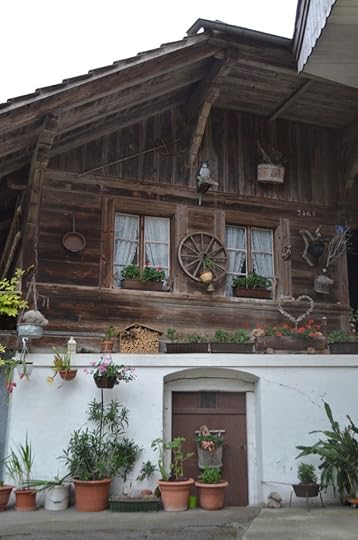
A typical home in Oey, Switzerland, right off main street.
The other ski resort is would also be considered local, but
this at least has five different, two-story chalets, two restaurants and a
sports center. It’s running now, and the dozens of mountain bike paths occupied
with avid outdoor enthusiasts.
Heading the other direction from town leads you across the lone bridge (and only ingress/egress) to Oey. Turning left heads you to Bern and Zurich, turning right to Thun, to Zermatt (prominently featured in my Danielle Grant romance series) through the Alps and in to Italy. In and around we have toured for five days and we want more!
What I loved
Everything I described. Our five-day, four-night stay on the farm was 574 Euro, which we thought was a screaming bargain. Goats, a pool, rabbits and farm fresh food? Any time.
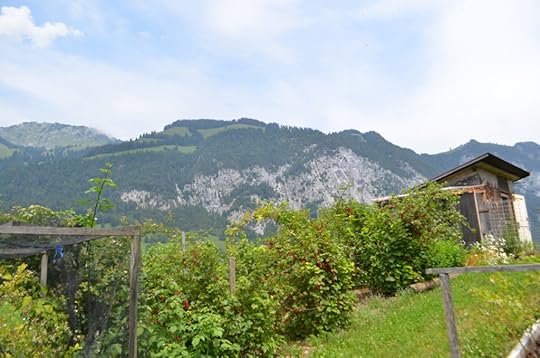
The Bern region of Switzerland, lush and warm, bulging with agriculture and recreation, skiing, hiking and climbing, Alps style.
What I didn’t
The internet service has been terrible. What I thought was poor in Germany was space travel compared to the automobile which, like any car, was periodically out of service or struggling to even start up. But that’s what you get in the middle of the mountains; a small sacrifice.
Recommendation
Definitely a must-do if you want the authentic, Swiss family farm style experience. What a blast of a time.
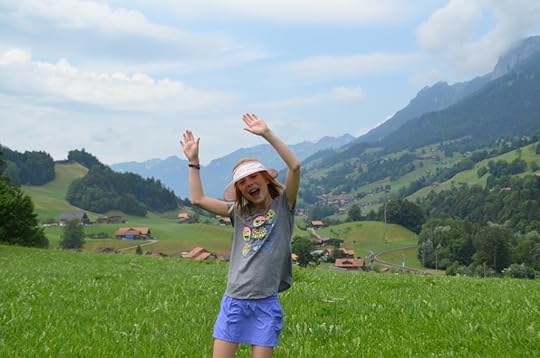
The hills are alive…wait, that’s Austria. Regardless, this is what staying on a farm will make you want to do: break out in joyful song, hands in the air.
Feature photo: taken from the grassland in front of the Familia Hermann farm.
July 3, 2019
Lichtenstein Castle, Germany
Four years ago, we were essentially lost on the backroads of Germany, which is what we refer to as “taking the scenic drive.” We had chocolate in hand and saw a few cars turning left up a long road and thought, ‘why not?’ It wasn’t until we drove into the parking lot and saw the castle on a piece of rock did we realize we’d stumbled on a castle.

This is taken from the armory, located across the bridge, opposite the castle
Getting there & parking
Lichtenstein Castle is on the way to (and about 20 min from) Burg Hohenzollern. If you drive too fast, you will miss the sign and right hand turn. Up a half a mile on paved road is upper and lower parking. The short walk up is on gravel, then arrival at the grounds. Tickets are cheap, 10 Euro for an adult, 7 for a child, and then you wait under the shade for your turn. The tours are limited to eight, which is about the max you can have in a lot of the rooms.
A little factoid is that during the war: the Allied forces had determined not to bomb many of the castles that we’ve seen during our travels, and I’m just so happy. This incredible feat of building the mini-but-super cool castle will be around for hundreds of years to come.

The walk to around one side of the castle
The tour
Sadly, no pics of the inside are allowed per usual, but official snaps can be seen on the website and available for purchase. My favorite room is the Knight’s Hall. It’s like a larger American dining room that would fit a twenty-person table. Along the upper moulding is actually a shelf with serious German steins, each with an insignia. Mounted heads of dead animals, boar being the primary one, are stuck on every available inch of wall space (that’s not why I like the room, it just comes with it). At the front is a pedestal, the kind you see at a conference facility, the wood ornately carved. We were told that from this, the hunters would hold a stein of beer and entertain the others with their stories of hunting greatness. I imagined fisherman doing the same: “It was the one that got away! It was thissssss big!”
On the left side of the podium is a secret door with a painted mural blending so well the tour guide had to open it up. This was the means for the Lord of the manner to escape the hunting room and go straight down to the den of sin, where his “ladies” waited for him as his wife was three stories up in her quarters.

This is a shot from the road down below, near the town (see further details in Tips)
The basic tour lasts 30 minutes and it’s of the first and second floors. The narrow, curving stairs weren’t all that hospitable, and that’s all we had time for. That said, the castle now offers a variety of tours, including the “Grand Tour” which we didn’t do because of the time constrictions. Next time around (if we are so lucky), I might be in for the 2-hour end-all-be-all tour. The list of tours with visuals is here.

Another view from the grounds
The grounds
Across and over the bridge is the gunnery, a round building displaying the cannons and other tools of war. It’s mostly closed off, but you can peek inside well enough to see how the soldiers shot their weapons on the invaders below.

The lower courtyard
For being so small and perched on a jutty of rock, the castle has a surprisingly gracious grounds to walk around. I can see the ladies of the joint enjoying the flowers under the shade of the trees.
What I love
The drawbridge over the infinite drop below, and the view of the castle from just outside the moat. It offers some of the most scenic portraits that even an amateur like me can pull off a good photo. I also love that pedestal and the visual of men lifting their steins, all hailing the boar that got away!

The armory is located on the corner overlooking the valley–and the only means up to the castle. This is one path
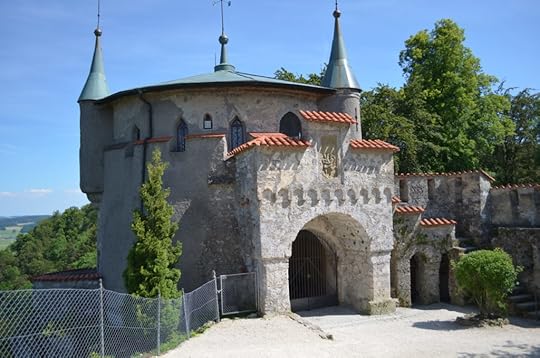
In a land where nary a guardrail exists, this has an actual fence, a strange site to behold.
What I don’t
Obnoxious tour companions. Ugh. We had another American who would not be quite, made loud noises throughout and constantly complained about not being able to take photos. About the time my mind started to go to a dark place, I just slotted her to the drawer of an annoying child, which fully enabled me to tune her out and go back to enjoying myself.
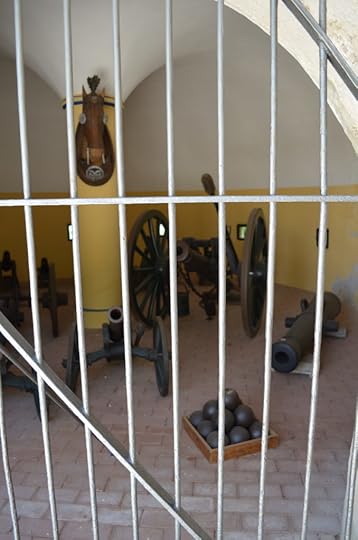
A peak inside the armory
Recommendation
Definitely do this if you have time. The tour is short, about 20 minutes, and well worth it. The grounds are lovely and small, so you can do the entire thing in less than an hour. No steep walks!

Every castle worth it’s weight needs a little dog door. Rog tried but didn’t fit
Tip: if you don’t have time to go to the castle, when you see the sign off for Schloss Lichtenstein, telling you to go left or straight, depending on your direction, instead, turn right, because the castle itself will be in your view. Doing this will eventually take you in to town, but half-way there, about five minutes going downhill, you can pull over, and from this vantage point, you can take the excellent shots from the road with your long lens. This way, you get the best (and only) shots without actually going on property, and missing out on your next destination.
Feature photo: drone shot taken by Rog as I took the manual shots
Lichtenstein Castle, German
Four years ago, we were essentially lost on the backroads of Germany, which is what we refer to as “taking the scenic drive.” We had chocolate in hand and saw a few cars turning left up a long road and thought, ‘why not?’ It wasn’t until we drove into the parking lot and saw the castle on a piece of rock did we realize we’d stumbled on a castle.

This is taken from the armory, located across the bridge, opposite the castle
Getting there & parking
Lichtenstein Castle is on the way to (and about 20 min from) Burg Hohenzollern. If you drive too fast, you will miss the sign and right hand turn. Up a half a mile on paved road is upper and lower parking. The short walk up is on gravel, then arrival at the grounds. Tickets are cheap, 10 Euro for an adult, 7 for a child, and then you wait under the shade for your turn. The tours are limited to eight, which is about the max you can have in a lot of the rooms.
A little factoid is that during the war: the Allied forces had determined not to bomb many of the castles that we’ve seen during our travels, and I’m just so happy. This incredible feat of building the mini-but-super cool castle will be around for hundreds of years to come.

The walk to around one side of the castle
The tour
Sadly, no pics of the inside are allowed per usual, but official snaps can be seen on the website and available for purchase. My favorite room is the Knight’s Hall. It’s like a larger American dining room that would fit a twenty-person table. Along the upper moulding is actually a shelf with serious German steins, each with an insignia. Mounted heads of dead animals, boar being the primary one, are stuck on every available inch of wall space (that’s not why I like the room, it just comes with it). At the front is a pedestal, the kind you see at a conference facility, the wood ornately carved. We were told that from this, the hunters would hold a stein of beer and entertain the others with their stories of hunting greatness. I imagined fisherman doing the same: “It was the one that got away! It was thissssss big!”
On the left side of the podium is a secret door with a painted mural blending so well the tour guide had to open it up. This was the means for the Lord of the manner to escape the hunting room and go straight down to the den of sin, where his “ladies” waited for him as his wife was three stories up in her quarters.

This is a shot from the road down below, near the town (see further details in Tips)
The basic tour lasts 30 minutes and it’s of the first and second floors. The narrow, curving stairs weren’t all that hospitable, and that’s all we had time for. That said, the castle now offers a variety of tours, including the “Grand Tour” which we didn’t do because of the time constrictions. Next time around (if we are so lucky), I might be in for the 2-hour end-all-be-all tour. The list of tours with visuals is here.

Another view from the grounds
The grounds
Across and over the bridge is the gunnery, a round building displaying the cannons and other tools of war. It’s mostly closed off, but you can peek inside well enough to see how the soldiers shot their weapons on the invaders below.

The lower courtyard
For being so small and perched on a jutty of rock, the castle has a surprisingly gracious grounds to walk around. I can see the ladies of the joint enjoying the flowers under the shade of the trees.
What I love
The drawbridge over the infinite drop below, and the view of the castle from just outside the moat. It offers some of the most scenic portraits that even an amateur like me can pull off a good photo. I also love that pedestal and the visual of men lifting their steins, all hailing the boar that got away!

The armory is located on the corner overlooking the valley–and the only means up to the castle. This is one path

In a land where nary a guardrail exists, this has an actual fence, a strange site to behold.
What I don’t
Obnoxious tour companions. Ugh. We had another American who would not be quite, made loud noises throughout and constantly complained about not being able to take photos. About the time my mind started to go to a dark place, I just slotted her to the drawer of an annoying child, which fully enabled me to tune her out and go back to enjoying myself.

A peak inside the armory
Recommendation
Definitely do this if you have time. The tour is short, about 20 minutes, and well worth it. The grounds are lovely and small, so you can do the entire thing in less than an hour. No steep walks!

Every castle worth it’s weight needs a little dog door. Rog tried but didn’t fit
Tip: if you don’t have time to go to the castle, when you see the sign off for Schloss Lichtenstein, telling you to go left or straight, depending on your direction, instead, turn right, because the castle itself will be in your view. Doing this will eventually take you in to town, but half-way there, about five minutes going downhill, you can pull over, and from this vantage point, you can take the excellent shots from the road with your long lens. This way, you get the best (and only) shots without actually going on property, and missing out on your next destination.
Feature photo: drone shot taken by Rog as I took the manual shots
Burg Hohenzollern, also known as Hohenzollern Castle
Our itinerary had us going south to Switzerland today, and we got a late start, but nothing was going to stop us from seeing Hohenzollern. Looking at the time (1 p.m.), we’d have two hours to arrive, grab a tour and then drive four hours south to the authentic farm we are renting (yes, you heard that right). More on that tomorrow, but for now, let’s focus on this incredible castle, which by the way, is still home to the last in the line, Prince George Freidrich of Prussia, his wife and four children often live in his “apartment” on one of the floors (or two) of this super-sized castle.

As I manned the physical camera, Rog handled the drone, and we tag-teamed to get incredible shots of this incredible castle. You can see a bit of the 3 sections, which started in the 11th century. Presently, Prince Frederick and his relatively new wife Sophie live in an entire floor (or more) of the castle. We missed the during our visit. Dang.
Getting there
Our map took us about 30 km from Stuttgart, and then by the backroads, so the last sixty minutes or so were dipping up and down, this way and that through the back fields of Germany. Like the Rhein part of Germany, this area doesn’t require irrigation, which is the primary reason both areas were always in some sort of war. He who had the food lived, and ironically, lots of people died in order for the few to live.

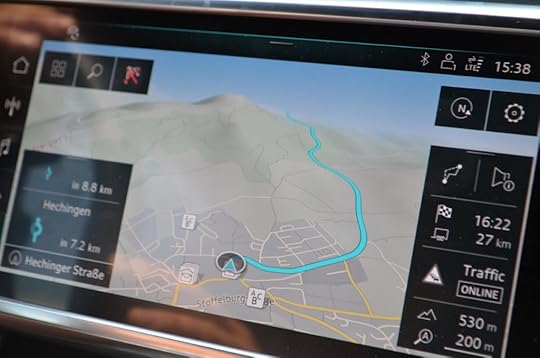

Passing through several towns on our way to Hohenzollern Castle–does one get more local this this?? (the navigation on the car shows the windy, back roads.
Off the road, it’s literally one right for a few miles and another right to the only castle entrance. Lots of lower area parking was available and 100% empty. At the very base of the castle is the smallest lot and ticket agent. We literally had front row parking, probably due to the fact everyone else was at Neuschwanstein in Fussen, but the reality of kids still being in school until the end of July didn’t hurt.

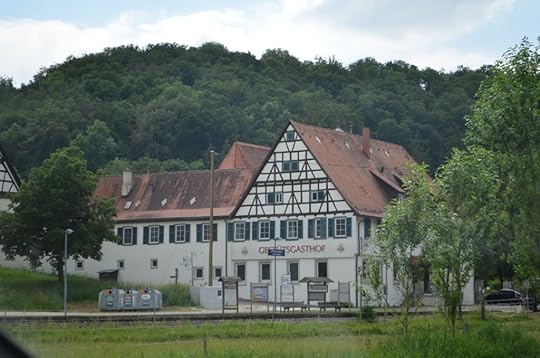
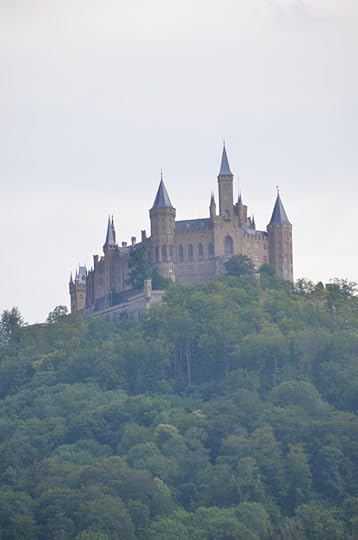
The final buildings before the last few miles which are nothing but agricultural fields. This was my stop-the-car shot, about a mile down from Hohenzollern with the long lens.
Tickets and walk
A family of four gets a discount and entrance fee, plus parking for 24 Euros. With the 45-minute tour, it’s only another four Euros! What a deal. More wonderful than the low cost—lower than Lichtenstein Castle, which we visited earlier in the day, the tour was limited to 12 people. Unfortunately, one thing was about the same—the gnarly walk up. In fact, Neuschwanstein was a longer journey up, but less fiercely steep. Hohenzollern is a shorter walk because it’s l about a 25-30% grade on the steps going right up. Several thousand wood, stone and brick steps are going to set you back 30 minutes, but we were late, so we practically ran up. My chest screamed and my legs ached, but we did it in 10.
I don’t recommend it.


Two types of paths–the first is the more gradual, then it’s stairmaster time
Of course, if we’d gone at a leisurely pace, it would have been 20, and all sorts of folks were making the trek. That said, if you want to take the car, it’s available. No horse drawn carriages though. This place is clean and simple.

A look up from as you walk the final 100 feet before you start yet another climb on the carriage road into the castle proper
The entrance and tour
Consistent with the other castles in Germany, the grounds are accessible and free to tour. Only the parking fee must be paid (if you don’t find free parking). The outside of the castles is like Hohenschwangau, because it’s expansive and lovely. Hohenzollern Castle truly goes 360 around the structure once you are on the grounds, which is pretty incredible. Unlike Neuschwanstein, which has valleys on one side and mountains on the other, Hohenzollern is all around valleys. It is literally on top of the world.



Two of the four drawbridges as you walk up, and the last one under a tower
The entrance and tour
The tours begin inside the castle, so you walk all the way through the carriage entrance, which is long and wide. Round and round you go, up and up on what was once the long, carriage drive over four different drawbridges, each one another means to prevent invading armies. Through the last entryway is the primary courtyard. It’s grand and great for photos. On the right is one of several stone stairways, one designated as the entrance.

The main outdoor courtyard–the chapel entrance to front left, the entry to the ancestral room to the right, where the two signs are placed. It looks like the predecessor for the two-story columns favored in the 80s homes built in the US.
The door is locked at all times, so be forceful when you knock, because that baby is solid wood, and enormous. Our tour guide answered, a kindly, German-speaking elderly man who showed us where to pick out felt slippers. One does not remove shoes in this castle; the oversized, McDonald’s-like slippers go right on.

Imagine your first invitation to the castle, and up you go to the double doors leading directly into the Ancestral Room. You crane your head up and around to the hand-painted genealogical chart spanning hundreds of years to the present day prince.
From there, the tour begins. Since we could only make the German-speaking tour, we were given free guidebooks with our tour in English. This wasn’t really necessary, however. Most of the rooms had displays with English subtitles. Only the smaller, inner chambers lacked this feature. Still, if you’re a history buff, grab the brochure, because it’s free and that way you don’t miss out.
What you see
Since this castle is so massive, the tour, while forty-five minutes, still only gives you a fraction of the space, but what you see is inspiring. The first room on the tour—and focal point for visitors past and present is the Ancestral Room, which is a two-story high room showing the dynasty on the walls, starting at the very top with the coat of arms for the family represented. The hand-painted ancestral chart shows the genealogy well enough for any quilter or family history expert to eye it with envy.

The castle was built in three phases–but it’s referred to as “three castles” because each one was completed on its own, not left unfinished. You can tell the evolution by the brick and structure.
From there, we were led to the count’s hall is for socializing, and we mistakenly thought it was a massive English-style dining hall, but no. Modern day designers surely copied the window seating which lines the entire room, along with tables set on either side, the inlaid marble flooring imported from Italy, and copied from the Karlstejn Castle in Prague (that’s where you can hold the eagle, owls and falcons, which I did and have the pictures. It was awesome). Since we visited that destination on our last visit, it was fun to notice the similarity. Massive iron chandeliers hang from above, ornate stain glass inlay is on every window, each offering glorious views to the valley below.
Then in to several inner chambers, a few of the Queens rooms as well as the Kings quarters. Hallways line the outside of the single floor, each and every single room covered with original, oil portraits of the home’s occupants. I inquired about the gold on the wallpaper with images of vines and flowers, and was told that yes, the room’s walls are hand painted gold leaf. In fact, all items in this castle are original, save for the curtains, which were replaced in the 2003 timeframe. You could tell where parts of the walls themselves had to be updated, because they were cracking. This is most likely due to the stone and concrete underneath sweating during the seasons, but it was insignificant, barely catching the eye.
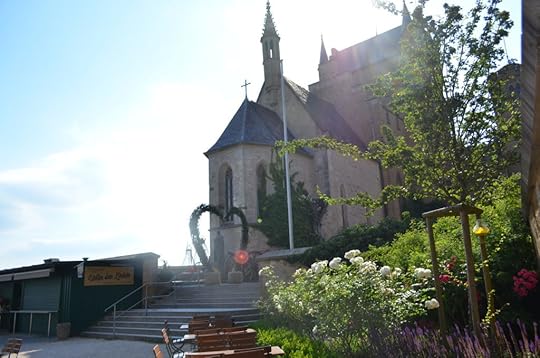
Just outside the chapel is this heart shaped metal with vines. Apparently, the castle is home to couples getting married. Below left is a large, outdoor eating area, which held large parties for those past and present
Always interesting: the small bedrooms
As with all the other castles, the actual bedrooms themselves are teeny, about 15×10 max, even for the King and Queen. The beds themselves are twins, and shorter than an American size. We hypothesize the rulers were too busy to hang out in the micro room. They had bigger and better things to be do.
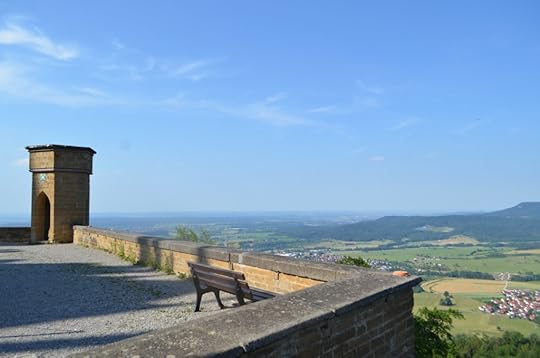
This castle offers a 360 view, the terraces extremely wide, the ledges thigh-height. If you fall, it’s a long drop.
The artifacts
In the final room of the tour within the castle is stocked with replicas of the crown and jeweled sniffing boxes, swords, flatwear and original clothing. Regarding the jewels, the guidebook identifies them as replicas, so it was unclear to me why it’s been put behind a three-inch piece of bulletproof glass, inset within a four-inch concrete frame, along with the three-inch steel door to shut when the visitors leave. Me being me, I inquired.
“Yes, these are replicas, but we are pretending they are real by virtue of the anti-theft elements just to make you think you’re in a museum.” Huh.
The tour guide confirmed what was in the guidebook: the real items are in the Berlin Palace, but the snifter boxes were stolen in a spectacular burglary in 1953.
The finale was a visit to the chapel was next, and it was as equally grand as the rest of the castle.

But wait, there’s more
Of all the floors and massive square footage (100+ thousand), we saw probably 3,000 square feet.
“What’s going on with all the rest?” I asked. I was told the present prince and his family occupy and entire floor (or more) of the three-part castle. I’d give that probably 20,000 square feet, give or take. It has its own private garden, two entrances and who knows how many square feet for staff and the like. Still, that leaves about 80,000 left unaccounted for. Still seeking a better answer, I asked the nice ladies at the information desk, they demurred; the sides of their lips turned down, eyelids lowered and a single nod of their head was all I got. It basically said: Didn’t your mother teach you any manners? So disappointed I even have to give you ‘the look.’
I’ll definitely use the look somewhere down the line in a book. It was a classic ‘older-woman-scolding another female who lacks couth.’

The formal entry into the large dining/outdoor reception area that is presently an outdoor café. This is where all the garden parties and outdoor social activity took place.
Tip: drones are allowed, and this is another
difference from the US or Mexico. In those areas, historical sites are mostly a
no-fly zone, and most drone systems link in to the FAA by law, identifying the
air space. This means Mt. Rushmore and so many other places are no-fly zones.
Compare that to Europe: the UK, Germany, and elsewhere. A
little notice pops ups, that is basically a disclaimer of damage. The operator
of the drone agrees that if the drone he/she is operating damages anything,
then they are liable. The airspace controller for that location has the code
for the drone operator so it would be tracked and validated.
Also, the elevation rules are totally different. One can get within 400 or 700 feet of the destination depending. This means better shots all around.

Key-hole shots around the entire perimeter, starting with the carriage road.
What I loved
Everything. I even liked the walk up in hindsight. All I need to do is visit a castle a day and my body will be bathing suit ready in no time.


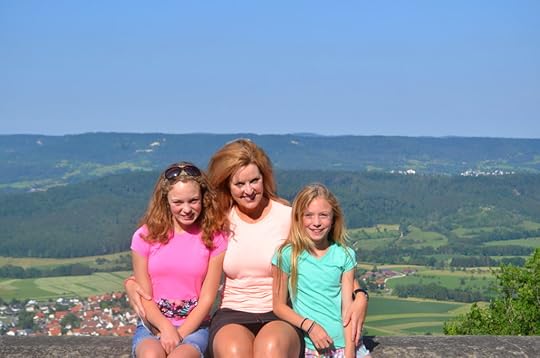
What I didn’t
Not seeing more of the castle.
Recommendation
Absolutely yes. It’s kid friendly, although we didn’t see any, other than our own. It’s also practically vacant, and we can’t understand why, but were happy to benefit from the absence of others.
Feature photo: taken from a drone flown by my husband, Rog, about a mile away from the castle
July 2, 2019
Tripsdrill: an authentically cool German theme park
Little did I know that its Porsche would usurp me as the family social director at the ripe, young age of 13. It was she who has found multiple theme parks that never even registered on either my, or Roger’s radar. The obscure castles and German-centric amusement recreation areas have been hidden in plain sight, arrived to find we are only non-German speaking folk about.
Getting there
Located just outside the city of Stuttgart, right smack in the middle of wine country, with a chateau perched on the nearest hill is Tripsdrill. I didn’t know much about it other than Porsche said we “must, must go there,” so we drove the 2 hours from our place in Kammeltal. Parking is free, plentiful and given it was a Monday, practically empty.
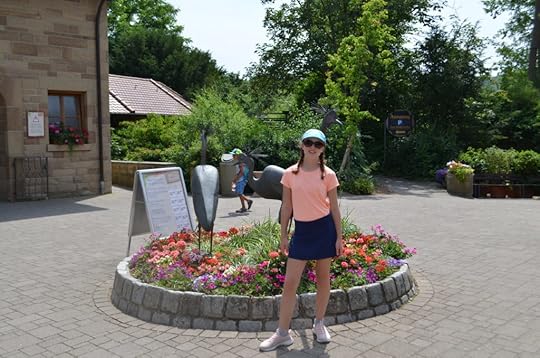

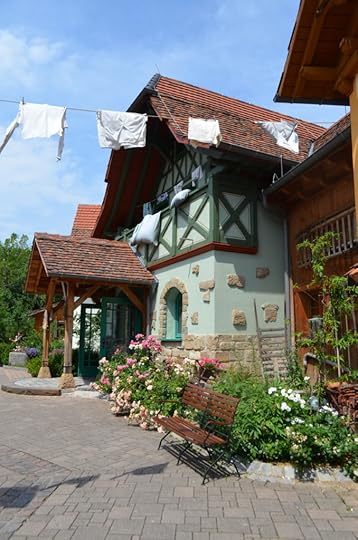
Another mostly empty theme park–this is the entry point, and the “streets” leading in to the rest of the park. Every attention to detail was made in creating this park; not a flower or piece of (real) laundry was out of place.
Two parks in one
For the grand price of about 40 Euros for a family of four, we had unlimited rides in the amusement park, and access to the wilderness park, which is about a 1km drive away, although you can walk. The wilderness park has animals of all types, with an eye towards those that can be held, touched, petted and played with. The lone exception to this is bear exhibit, even the German’s have a line. But the deer, falcons, goats and every other relatively tame, non-carnivore is available.



Two giant treehouses hold up one of those dropping/fluctuating rides that make your stomach go into your throat, then down into your bowels and back again. We passed on that, choosing to pet and scratch the goats that were directly across. The bottom picture would make Andretti proud; it’s a mini-race course.
One thing about the German mentality is the responsibility-based approach. Ergo, there’s nary an attendant or monitor at any station. If your kid gets stomped by a deer or a finger bitten off by a goat, your bad as a parent. At every entry point, one, waist-high swinging door is followed by another. It’s your responsibility to ensure the animal doesn’t escape from the first, or second. And following Darwin’s theory, if you allow a four-legged creature to outsmart you or your child, you get to go chase it.
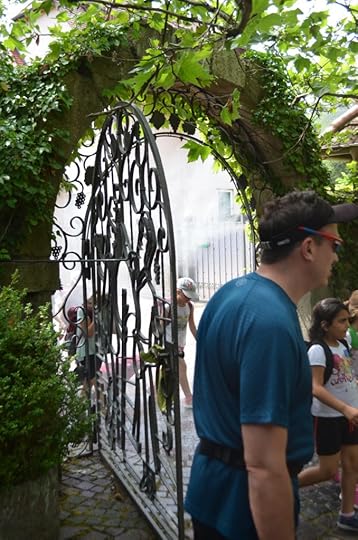


The upper left is the misting I mentioned, while the right is the agriculture area where the ride is conducted in wine barrels. The bottom is one of three water rides–note the edge on the right–look mom–no rails, or guards to prevent one from falling in.
Moving on to the amusement park, this same attitude prevails. As an example, two water log rides exist, one for kids under 13 (although adults can ride on it as well) and another for adults (although kids above a certain height can also ride). Right next to the water are paths of stone, where anyone and everyone is allowed to sit and dangle their feet. In Germany, and most European countries, it’s all about self-responsibility. If you or your offspring fall into the water and hurt themselves, you pick them up, dust them off go on with your day. Companies are protected from the consumer (prevented from lawsuits), and as such, can offer amazing experiences where one isn’t inhibited. Ergo, parents aren’t on their phones, but watchful and playing with their kids, which is a beautiful experience all around.
An education environment celebrating German engineering achievements
Tripsdrill is not just any theme park, where the rides are the end-all-be-all. This is about the full experience of educating the visitor as they wait in line, grab a snack or drink a glass of wine. Wine making is dominant in this area, so an area consisting of its own, originally-styled wine-making barn sits next to four different smaller buildings, each one with original pressing (or whatever it’s called) equipment. Sorry, I don’t drink or know much about wine, or speak German, but know lots of people who do would appreciate this, along with the free drinks served.



These are just a few shots from the inside of the castle which houses the sleigh roller coaster ride, hence, the entirety of the displays are life size items relating to sleigh making.
A few other examples include the sleigh roller coaster. This
is located in a castle, wherein the signs posted show waits of 2 hours at the
entry. We arrived on a Monday, so we walked right up and on to the rides, but
the Germans, anticipating rush hour, take advantage of every step to educate
you on the sleigh making. Within the building are lifestyles, custom mannequins
demonstrating all things sleigh, starting with the stables) grooming and
doctoring the horses—which actually include the horse, all the tools and items
for medicate attention, and even a side stall where a person sleeps near his
horses. The next area within the wait line is a huge movie screen, showing a
black and white film of the old days of sleigh making. The walkway is one story
up, looking down below on a recreated outdoor scene of a winter wonderland.
This continues right up until you enter the ride.
Each ride has its own focus, from the kids spinning ride, where the cup is actually a bread bowl, and all the surrounding items focus on bread, to the swing ride that’s a three-story high mushroom, and the wait line is all about agriculture. The entry to the wooden rollercoaster, (the smoothest, and best one we’ve ever ridden, I shall add), is all about mill working. It’s like the anthology of using and applying lumber, the first tools and wheels, to then more sophisticated equipment and applications—cutting, slicing, and manufacturing. All I could think about was my father, who would have cared less about the ride, but hung out for hours oohing and aahing about the machinery.

Notice the wooden roller coaster in the back left? In between that and this monster-of-all wooden forts is the lumber section, where riders waiting in line get to see the history of millworking.
Me and Rog were right there with him, and had a moment of
silence in his absence.
I’ve just got to mention a third water ride, which is the rafting. In the US, you have to wait your turn, the attendant directs a group one a time to get in, and that’s that. Well, here, since there’s no attendant, and the round floats come up the metal ramp without assistance, those in line are left to their own to walk on the wet, moving ramp of metal, get in (no straps mom!) which fit 12, three to each section, and sit down before it goes off the ramp, plunging in to the water below. Guess what? No age limit on the kids either, but nary a problem or mishap.

If you’re going to be launched out on a water log, do it from a castle, I say.
A note on rides all around Germany
Pretty much it’s void of lockers. Everyone works on the honor system, which means that the backpack or purse you are carrying is placed on the shelves by the ride. You set it down prior to getting in, go on the ride, then pick it up. A few years back we were leery of this, but shouldn’t have been. Stealing doesn’t happen here. So it was that I’ve been removing my pack with all my camera gear, wallet and sundries, placing it on the shelves or ground, and pick it right up after the ride is done.

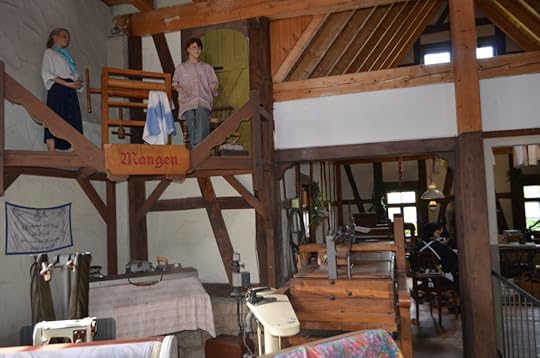

A few of the displays regarding sewing–from the most basic, through to the looms, including all the machines and irons. These women worked hard and were talented!
Other niceties
Each and every ride and planter box has been treated with care. It’s as though a master gardener (or 12) have been cultivating this park for years, and this is the glorification of their work. I took over 110 shots of this park, more than all the castles and destinations combined, but know you might suffer from overkill. Yet I’m giving them credit through the mention, because it’s deserved.

This attraction/ride was all about the history and art of breadmaking, hence, they are in a bunt cake!
Another nice touch are the arched entrances that double as misters, not enough to ruin the makeup or hair, but cool you down. Not a bench exists for resting that isn’t situated under shade and my favorite part (although unused by us?) The metal chaise lounge chairs where adults could take a breather as their kids play in the park. We need these in America!!!
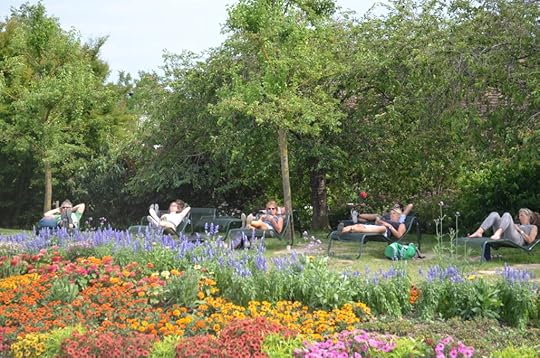
Seriously civilized living; the parents kick back, read, snooze or watch their kids across the flower beds in the large lawn.
The food was tremendously great, pizza, schnitzel and bratwurst, all tasting farm fresh, as well as the baguettes probably baked that morning. Germans know how to eat, is all I’m saying.
Final note
I’ve touched on the honor system, but today’s experience
takes the cake. We spent nearly six hours at the park (when we anticipated
about three) and couldn’t find our care. Now, there’s only about 4, double
parking lanes that were full, and from a distance, I thought I saw our car, but
the trunk was open, so we walked on. Reaching the grass parking area, we turned
back, double-checking our eyes. Indeed, the trunk was open, because the
groceries we’d purchased that day, from water bottles, fruits and veggies. Furthermore,
my long lens was in the glove compartment, which was unlocked, and my metal
water bottle and sunglasses were also in the car.
We realized that Rog’s remote must have gotten accidentally
punched as we walked away, and four six hours, the trunk was open, and car
unlocked. Not a single item was out of place or missing.
One word. Wow.
Final tip to a new traveler
I lied, another note. When it’s lunchtime, everything just down. The grocery stores. The banks. The gardening shop. Trust me, we’ve tried all three things between the hours of 12-1 over the last five days and can vouge that it hasn’t mattered what town, it’s all done for, which actually, is a great thing. Everyone takes the break at the same time, for a full hour.
What I loved
All of it. Period. The end.
What I didn’t….
That the three water rides closed at 4:30, while the park itself closes at 7. The wilderness park doesn’t allow entrants after 6 p.m. to allow an hour for late starters.
Recommendation
An absolute must if you have kids, or love German history and manufacturing. Rog and I agreed that if we lived here, we would have seasons passes. I’m not sure I’d ever get tired of Tripsdill.
Feature image: the roller coaster in the foreground of the chateau. only in Germany



